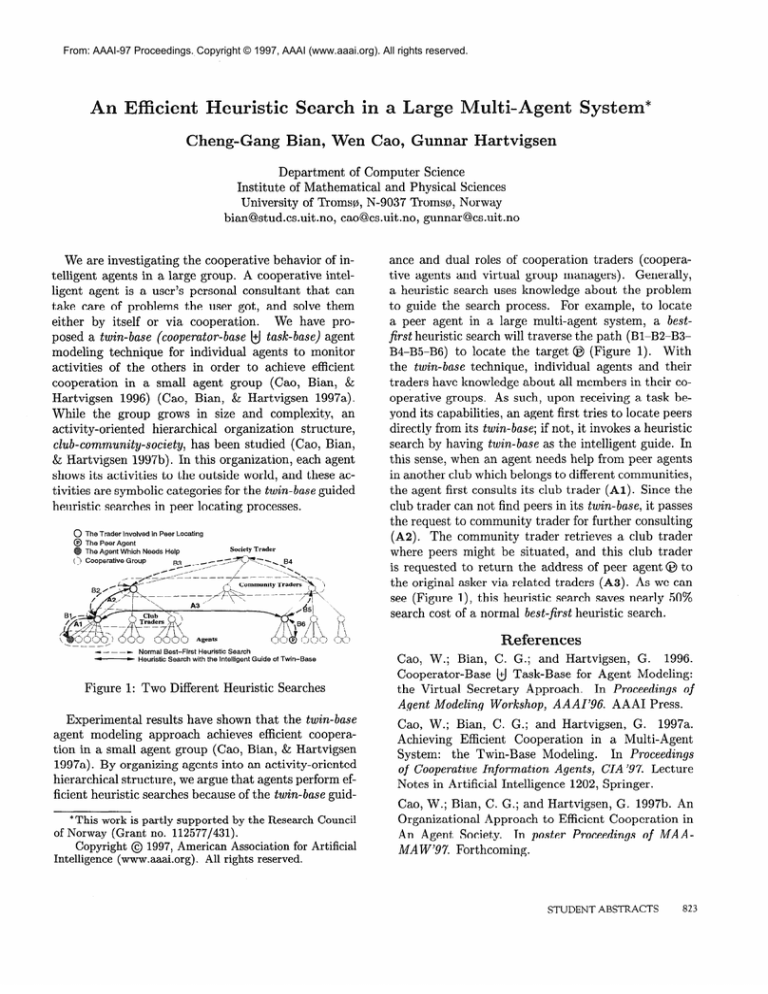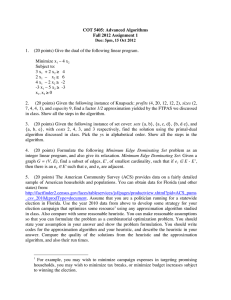
From: AAAI-97 Proceedings. Copyright © 1997, AAAI (www.aaai.org). All rights reserved.
gent
euristic Searc
Syste
Cheng-Gang Bian, Wen Cm, Gunnar Hartvigsen
Department of Computer Science
Institute of Mathematical and Physical Sciences
University of Tromso, N-9037 Tromso, Norway
bian@stud.cs.uit .no, cao@cs.uit .no, gunnar@cs.uit .no
We are investigating the cooperative behavior of intelligent agents in a large group. A cooperative intelligent agent is a user’s personal consultant that can
take care of problems the user got, and solve them
We have proeither by itself or via cooperation.
posed a twin-base (cooperator-base
u task-base) agent
modeling technique for individual agents to monitor
activities of the others in order to achieve efficient
cooperation in a small agent group (Cao, Bian, &
Hartvigsen 1996) (C ao, Bian, & Hartvigsen 1997a).
While the group grows in size and complexity, an
activity-oriented
hierarchical organization structure,
club-community-society,
has been studied (Cao, Bian,
& Hartvigsen 199713). In this organization, each agent
shows its activities to the outside world, and these activities are symbolic categories for the twin-base guided
heuristic searches in peer locating processes.
0
@
The Trader
involved in Peer Locating
The Peer Agent
The Agent Which
( _‘ Cooperative
Needs Help
Society
Trader
Group
ante and dual roles of cooperation traders (cooperative agents and virtual group managers).
Generally,
a heuristic search uses knowledge about the problem
to guide the search process. For example, to locate
a peer agent in a large multi-agent system, a bestfirst heuristic search will traverse the path (Bl-B2-B3B4-B5-B6)
to locate the target @ (Figure 1). With
the twin-base technique, individual agents and their
traders have knowledge about all members in their cooperative groups. As such, upon receiving a task beyond its capabilities, an agent first tries to locate peers
directly from its twin-base; if not, it invokes a heuristic
search by having twin-base as the intelligent guide. In
this sense, when an agent needs help from peer agents
in another club which belongs to different communities,
the agent first consults its club trader (Al). Since the
club trader can not find peers in its twin-base, it passes
the request to community trader for further consulting
(AZ). The community trader retrieves a club trader
where peers might be situated, and this club trader
is requested to return the address of peer agent @ to
the original asker via related traders (As). As we can
see (Figure l), this heuristic search saves nearly 50%
search cost of a normal best-first heuristic search.
eferences
-s-----)_
4
c
Normal Best-First
Heuristic Search
Heuristic Search with the Intelligent Guide of Twin-Base
Figure 1: Two Different Heuristic Searches
Experimental results have shown that the twin-base
agent modeling approach achieves efficient cooperation in a small agent group (Cao, Bian, & Hartvigsen
1997a). By organizing agents into an activity-oriented
hierarchical structure, we argue that agents perform efficient heuristic searches because of the twin-base guid*This work is partly supported by the Research Council
of Norway (Grant no. 112577/431).
Copyright @ 1997, American Association for Artificial
Intelligence (www.aaai.org). All rights reserved.
Cao, W.; Bian, C. G.; and Hartvigsen, G. 1996.
Cooperator-Base
l+J Task-Base for Agent Modeling:
the Virtual Secretary Approach. In Proceedings of
Agent Modeling Workshop, AAAI’96.
AAAI Press.
Cao, W.; Bian, C. G.; and Hartvigsen, G. 1997a.
Achieving Efficient Cooperation in a Multi-Agent
System: the Twin-Base Modeling.
In Proceedings
of Cooperative Information
Agents, CIA ‘97. Lecture
Notes in Artificial Intelligence 1202, Springer.
Cao, W.; Bian, C. G.; and Hartvigsen, G. 1997b. An
Organizational Approach to Efficient Cooperation in
An Agent Society. In poster Proceedings
of MAAMAW’97.
Forthcoming.
STUDENT ABSTRACTS
823






